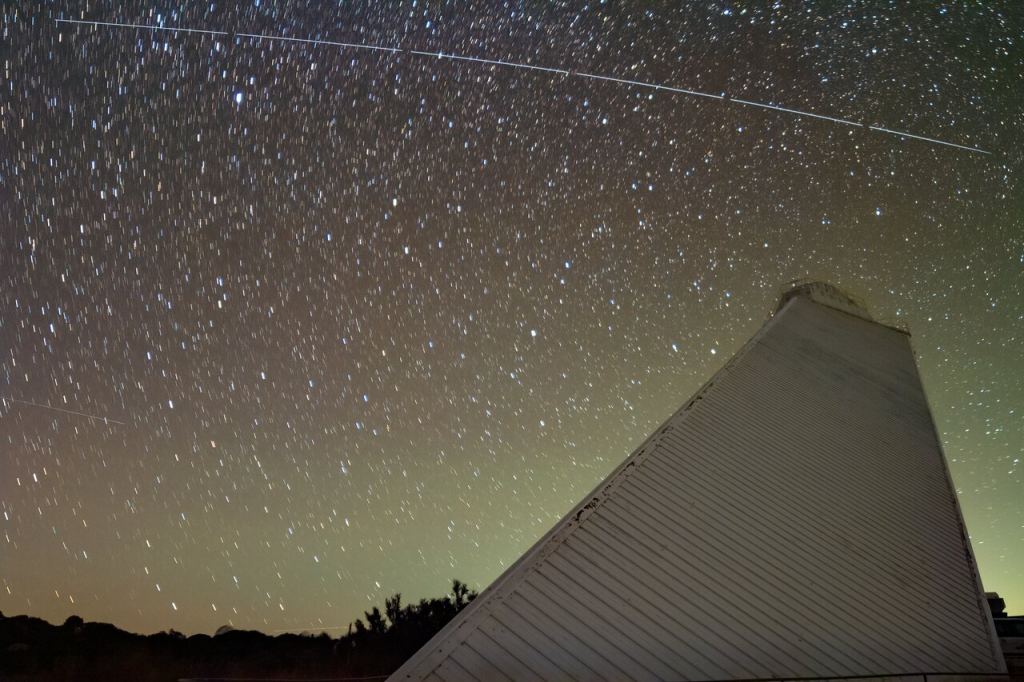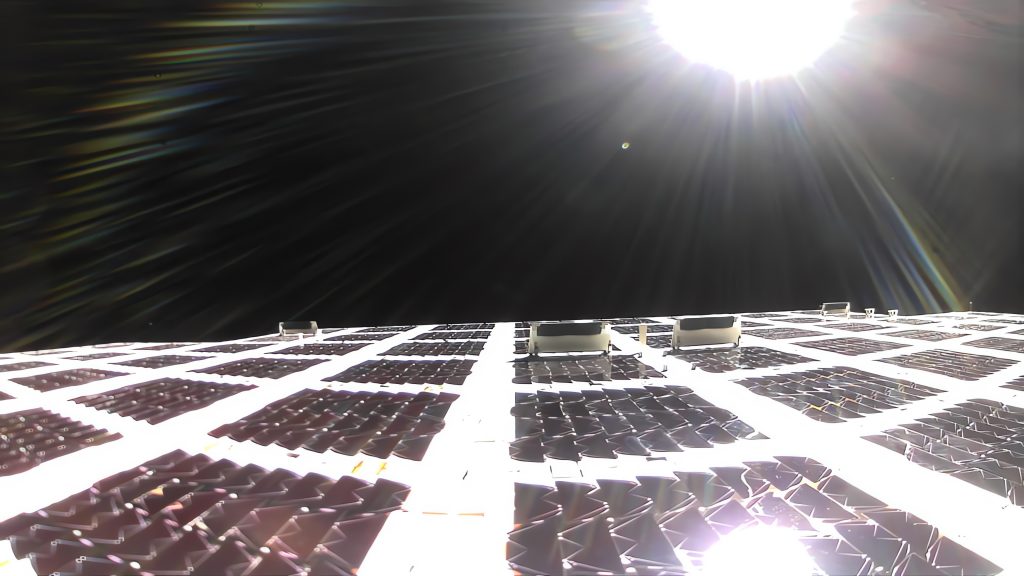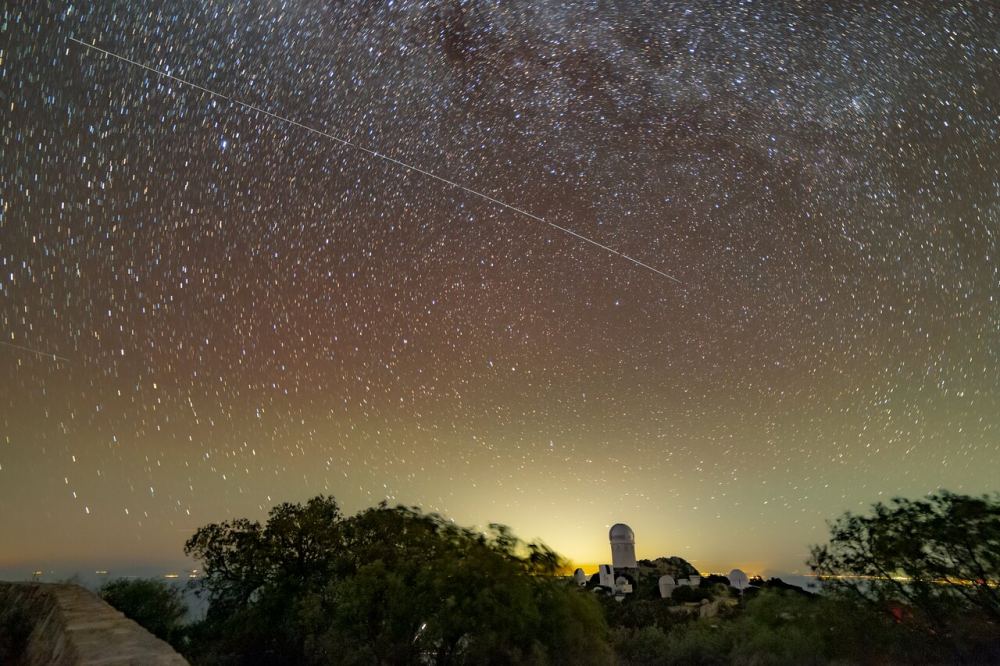It seems our nighttime skies are hosting another new communications network. In recent years, we’ve seen Starlink trains of satellites moving against the backdrop of stars, and more OneWeb satellites will soon be heading to orbit. Now, it’s BlueWalker 3, a prototype test satellite for a new communications constellation aimed at cell phones. Think of it as the first of many “cell towers in space” providing communications access for people around the globe.
While all of these satellites can affect astronomy, BlueWalker 3 recently caught the astronomy community’s attention because it’s big and bright. In fact, it can get as bright as a visual magnitude of 1 (about as bright as Altair or Spica). It also emits a specific set of radio frequencies. Because of this, the International Astronomical Union released a statement about its effect on research.
The company launching this prototype test satellite, AST SpaceMobile, says it has been in contact with the IAU and the astronomy community to mitigate the system’s effects on astronomy. Other companies are working with astronomers, too, to mitigate their system’s effects on observations. At stake are the conflicting needs of communications companies to make their product available stacked against the needs of the astronomy community to continue its discoveries among the stars.
The IAU and BlueWalker 3
The IAU is the global gathering of astronomers. It advocates for the promotion and safeguarding of all aspects of astronomy and science education. In its release, the organization pointed out its concerns about BlueWalker 3’s visibility, saying, “This low Earth orbiting satellite is now one of the brightest objects in the night sky, outshining all but the brightest stars. In addition, the satellite’s use of terrestrial radio frequencies poses a new challenge to radio astronomy.”
Radio astronomy observatory personnel raised the alarm about the effects on their work. Ground-based observatories are concerned, too. These include NSF’s NoIRLab, and the Square Kilometer Array Observatory (SKAO).
“Astronomers build radio telescopes as far away as possible from human activity, looking for places on the planet where there is limited or no cell phone coverage. Frequencies allocated to cell phones are already challenging to observe even in radio-quiet zones we have created for our facilities. New satellites such as BlueWalker 3 have the potential to worsen this situation and compromise our ability to do science if not properly mitigated,” said SKAO Director-General Philip Diamond. “This is a key reason why the SKAO is deeply involved in the IAU CPS and promoting the equitable and sustainable use of space.”

About BlueWalker 3
The BlueWalker 3 platform is a product of AST SpaceMobile, based in Midland, Texas. The aim of the their satellite constellation is to solve a problem that faces billions of people around the globe: a lack of connectivity. The prototype satellite is the largest-ever commercial communications array deployed in low Earth orbit. It will be accessible by cellular devices via 3GPP standard frequencies at 5G speeds. The platform should have a field of view of over 300,000 square miles on the surface of the Earth.

This is a first-of-its-kind space-based cellular network that can reach areas that aren’t being served by current networks. The design of the system requires not more than 168 satellites—orders of magnitude fewer than other networks have or are planning to put into orbit.
An AST SpaceMobile spokesman shared that the company has been working with the IAU and other astronomy groups on ways to reduce the system’s effects. “We are eager to use the newest technologies and strategies to mitigate possible impacts to astronomy,” they said. “We are actively working with industry experts on the latest innovations, including next-generation anti-reflective materials. We are also engaged with NASA and certain working groups within the astronomy community to participate in advanced industry solutions, including potential operational interventions.
“As part of this work, AST SpaceMobile is committed to avoiding broadcasts inside or adjacent to the National Radio Quiet Zone (NRQZ) in the US and additional radioastronomy locations that are not officially recognized, as required or needed. We also plan to place gateway antennas far away from the NRQZ and other radio-quiet zones that are important to astronomy.”
Finding Common Space for Both Needs
The conflict between astronomers and communication satellite operators will ultimately come down to technological solutions. Both sides are already working together to find ways to have global communications AND explore the cosmos. The concerns are very real, in particular for the Vera Rubin Observatory in Chile. It is an all-sky survey facility set to begin operation in 2024. In a statement released this past summer, the Rubin Observatory offered a detailed analysis of the challenge. It pointed out that ultimately as many as 30 percent of all its images will contain at least one satellite streak. Very bright satellites could completely saturate its survey camera’s CCDs. Astronomers are looking at ways to mitigate this issue for VRO, including beefing up its scheduling algorithm to account for passes.

Astronomers and Industry Meet to Solve the Challenge
To understand the effects on astronomy of the increasing number of satellites in low-Earth orbit, the American Astronomical Society convened a series of workshops under the name SatCon 1 and SatCon 2. They produced recommendations for reducing the effects of satellites on astronomical observations. Among them is the idea of collaboration between satellite operators and observatories to predict the positions of satellites so that observations can be programmed to avoid most (if not all) passages.
Another idea is to change the reflectivity of the satellites. Certainly, dark coatings on their surfaces do reduce their brightnesses. For example, SpaceX experimented with something called “DarkSat” and astronomers reported a marked change in satellite brightness. The company also deployed a type of sunshade dubbed “VisorSat” to reduce Starlink satellite reflectivity. These haven’t completely solved the problems, but mark a step in the right direction. AST SpaceMobile is also looking at these technologies for their next-generation satellites. This test flight for BlueWalker 3, along with input from NASA and IAU working groups should help the company refine its satellite design, as well.
Astronomers are also looking at ways to mitigate the effect of satellites on observations at Vera Rubin by reprogramming its scheduling algorithms. With a reasonably accurate satellite orbit forecast, the observatory could avoid “seeing” some satellites during its operations. This is still a work in progress but requires much more information about the orbits, the surface brightnesses of the satellites, and other systematic errors that could creep into the forecasts.
Charting Satellites in the Sky
To help astronomers and companies like Starlink and AST SpaceMobile understand the effects of these new satellites, the IAU’s Center for the Protection of the Dark and Quiet Sky from Satellite Constellation Interference (CPS) office invited observations of BlueWalker 3, Starlink, and other satellites. Observers can submit visual and telescopic information about what they see to SatHub.
The CPS recognizes that these new satellite constellations are responding to a global need for improved communications. That means future versions of the satellites should be much more compatible with the needs of the astronomy community.
For More Information
IAU CPS Statement on BlueWalker 3
AST SpaceMobile Deploys Largest-Ever Commercial Communications Array in Low Earth Orbit

